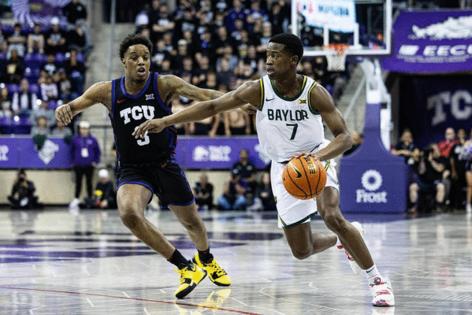David Murphy: Trade up for Dylan Harper? Sure, but Sixers have a fine consolation prize at No. 3.
Published in Basketball
PHILADELPHIA — The more I watch VJ Edgecombe, the more I think that the Sixers shouldn’t be looking to trade down.
Trade up? Sure. But that’s probably not going to happen. Not with a prospect like Dylan Harper on the board. Most years, he’d be the unquestioned No. 1 overall pick. He isn’t a surefire generational talent like Cooper Flagg. But he has a smooth, polished offensive game that comes with a 6-foot-10 wingspan and a hefty 213 pounds on a 6-foot-4 1/2 frame. This is one of those years when the difficult decisions begin at No. 3.
A lot of what you read between now and the June 25 draft will be little more than smoke. That’s how it goes in mid-June, especially in a year like this, when the gaggle of less-than-elite prospects invokes such divergent opinions as this one. You can try to talk yourself into believing that the Spurs could be reluctant to add Harper to a backcourt that already includes De’Aaron Fox, Devin Vassell and Stephon Castle. A recent report from HoopsHype said that the Sixers had held conversations with the Spurs about the No. 2 overall pick. Back when I was single, I used to hold conversations with my dog about lots of topics. They never amounted to much.
So, yes, of the three general paths the Sixers could follow at No. 3, trading up a spot to draft Harper is No. 1. The more relevant question concerns the order of the other two scenarios.
A month ago, I would have told you that the Sixers should be looking to trade down. In fact, I did tell you that. I was focused mostly on Ace Bailey at the time. Harper’s teammate at Rutgers, Bailey possesses a combination of athleticism and physical measurables that tends to make NBA general managers throw caution to the wind. His seven foot wingspan and 8-11 standing reach both measure a half-inch longer than Flagg’s. Combine that with his alleged shooting ability and you have a player who will convince a lot of executives that he is tailor-made for the modern NBA game.
The problem with that thinking is that the modern NBA game ain’t so modern anymore. Remember “Pace and Space?” It isn’t dead. It also isn’t a cheat code.
This year’s Eastern Conference finals featured a couple of teams that ranked 21st and 28th in 3-point attempt rate. The Oklahoma City Thunder also ranked in the bottom half of the league in 3-point attempt rate.
Meanwhile, an interesting development has occurred with pace of play. Ten years ago, pace rating was one of the holy statistical grails of the ahead-of-the-curve-and-proud-of-it set. A measure of the number of possessions an offense has over the course of the game — the faster each possession, the more you can fit into four quarters — the leaguewide average exploded from 93.9 in 2014 to 100.3 in 2019. But then a funny thing happened. Over the last four years, the league’s pace rating has normalized between 98 and 99. Perhaps we have arrived at the midcentury modern NBA.
None of this should surprise anybody who thinks a little bit about human behavior and the statistics we use to measure that behavior. History is a tango between progress and reaction to that progress. You can only stay ahead of curve for so long. Eventually, the curve shifts.
Over the last several years, the NBA has seen a reaction to the reaction. In a world where everybody is playing with pace and letting it fly from behind the arc, the competitive advantage goes to the teams that are better at defending against those things. Thing is, you still have to be good at playing with pace and shooting the 3. The potential for competitive advantage exists on the defensive end because it takes a special kind of player who can excel in that sort of offensive environment and also have enough energy and instincts left over for the other end of the court.
The midcentury modern players are OG Anunoby, Aaron Nesmith, Luguentz Dort, etc. The ability to hold one’s spot and beat the shooter/ballhandler to his are just as important as length. There will always be a place for the elite offensive player — Jalen Brunson, Luka Dončić, etc. But if you aren’t elite, you had better be able to contribute both ways. Nothing that I’ve seen out of Bailey suggests he is a midcentury modern sort of player.
Where I’ve shifted my thinking is with Edgecombe. Rather than looking to diversity their risk portfolio and move down, the Sixers might be better off staying at No. 3 and grabbing the soon-to-be 20-year-old Bahamian out of Baylor. They reportedly have worked him out and wined and dined him and flown Tyrese Maxey in to take part in the festivities. They also reportedly will hold a private workout with Bailey. But Edgecombe is the guy if they stay at No. 3.
None of his measurements jumps off the page, but he measures respectably in all of them. His 6-7 1/2 wingspan and 8-5 1/2 standing reach are nearly identical to Oklahoma City’s Cason Wallace and Boston’s Derrick White. What pops on film is the center of gravity and the frame that seems tailor-made for filling out. He plays bigger than he is, to an extent that it makes his explosive vertical leap and smooth speed look even more conspicuous. The toughness and instincts are evident: He averaged 5.6 rebounds and 2.1 steals as a 6-5 freshman at Baylor. The shooting mechanics make you think the 34% three-point percentage can grow. There is also a vision and reaction to his passing that belies his 3.2 assists per game.
Edgecombe may not have the upside that an executive will see in players like Bailey or Texas’ Tre Johnson. But he is a player who looks a lot like the ones you see on the court in this year’s NBA Finals, if not in form then in spirit.
The Sixers should absolutely fish for an offer they can’t refuse. And they should absolutely try to make one to the Spurs. Absent both, Edgecombe is a worthy consolation prize.
©2025 The Philadelphia Inquirer. Visit inquirer.com. Distributed by Tribune Content Agency, LLC.







Comments